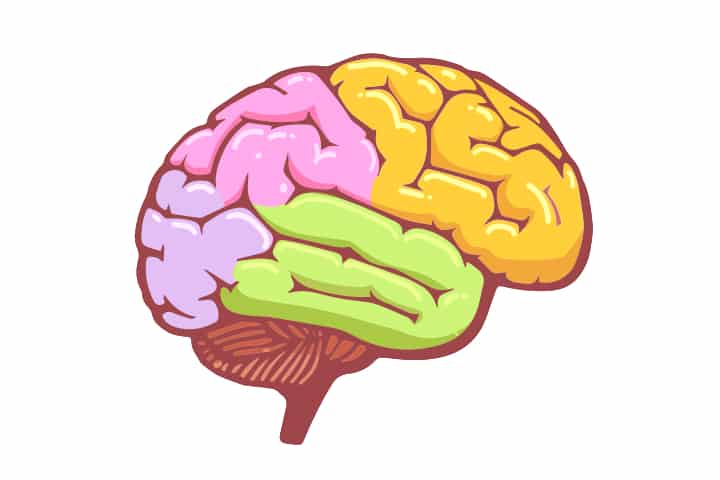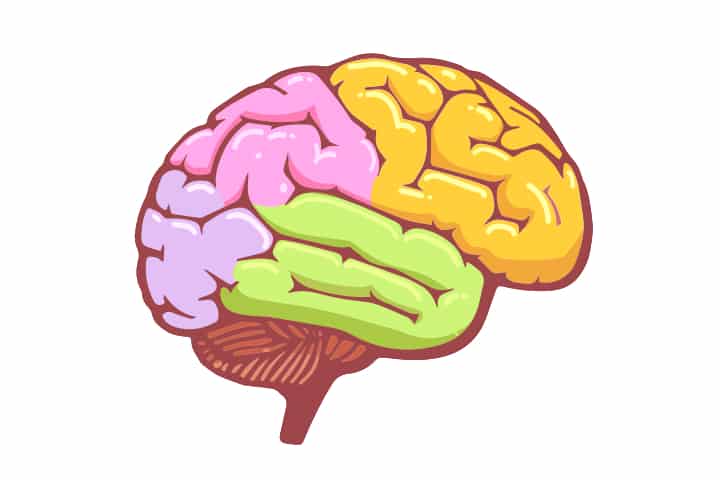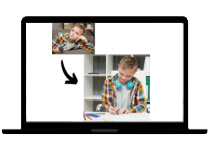Reading the Development of Children by Mary Gauvain and Michael Cole Workcited
Statistics | Milestones | When does the brain terminate developing | Experience-dependent | Critical periods & Plasticity | Nature vs nurture | Early on Years
Encephalon Evolution
Early babyhood is a time of tremendous brain evolution. The young brain literally changes shape and size in response to everything encountered in the early years. New environments, life experiences, caretakers, and relationships tin all bear upon the style complex brain circuits are wired. This network of synaptic connections will ultimately decide brain function and the evolution of behavior.
Statistics
- An infant'south brain at birth has roughly 86 billion encephalon cells (neurons) one , almost all the neurons the human brain will ever have 2 .
- Although a newborn has almost the same number of neurons as an adult, it has only 25% of the adult size.
- Baby'south neurons are continued by just roughly 50 trillion neural connections, called synapses, whereas an developed brain has about 500 trillion of them 3 .
- By age 3, the synaptic connections have grown to one thousand trillion.
- A child's encephalon volume reaches 90% completion roughly past age v 4 .
- During adulthood, the synaptic density will be half that of a toddler at age 2.

Early Developmental Milestones
Here are some of the childhood evolution milestones:
- Calendar week 3 post-conception – neuron production begins in the fetal brain.
- At nativity – auditory arrangement matures v .
- 5 weeks – learning and memory formation.
- 9 months – big motor skills.
- 1 year 3 months – speech.
- 1.5 years – fine motor skills.
When Does the Brain End Developing
On boilerplate, the brain stops developing effectually age 25. Although an individual's brain growth trajectory can vary slightly, most people's healthy brain development is consummate in their mid-20s.
The prefrontal cortex is the terminal encephalon region to develop.
Nevertheless, it doesn't mean the brain stops changing.
Forming and irresolute interconnections in our brain is an ongoing process that takes place throughout our lives. But as we age, they do so at a much slower charge per unit.
The feel-dependent encephalon
One of the almost prominent characteristics of human encephalon evolution is synaptic pruning.
The network of synapses grows chop-chop during the first year and continues to practice and so during toddlerhood.
Life experience will activate certain neurons, create new connections between neurons and strengthen existing connections, called myelination.
Unused connections will eventually be eliminated during synaptic pruning 6 .
Synaptic pruning is the neuronal procedure in which unused neurons and synapses are eliminated to increase efficiency in neuronal transmissions. This process occurs later synaptic growth between early childhood and puberty.
Because life experiences can literally shape the brain, babies can adapt flexibly to any surroundings they're built-in into 7 .
But that also means what parents do or don't do during the determinative years can have a profound impact on the child's healthy development – mental health and physical health.

Critical Periods & Plasticity
Within early childhood, developmental timing is as well of import. There are windows of time when unlike regions of the brain become relatively more sensitive to experiences.
This menstruum of babyhood brain development is called a disquisitional period or sensitive period.
During a critical period, synaptic connections in certain brain regions are more plastic and malleable. Connections are formed or strengthened given the appropriate childhood experiences. Afterward the disquisitional period has passed, the synapses become stabilized and less plastic.
For instance, language learning is much easier for young children. They can learn a nonnative language and attain proficiency more hands before puberty. So the sensitive period for linguistic communication development is from nascency to before puberty.

Besides See: Benefits of Sensory Play to Encephalon Development

Nature vs Nurture In Child Development
Too influencing the evolution of brain architecture, early life experience has another pregnant impact on a kid's development.
A large amount of scientific show indicates that life experience can affect gene expression — how data in a gene is used (epigenetics) — in some cases by slowing or shutting the genes off, and in others by increasing their output 8 .
This is why identical twins are not carbon copies of each other.
Although their genes (Dna code) are identical, their epigenetic markers are different from nascency and go on to diverge as they interact with the environment in distinctive means.
Even more than of import, these epigenetic changes tin can be permanent and passed down from generation to generation.
In the age-old nature-versus-nurture debate, epigenetics offers a surprising middle basis.
Genes are profoundly of import, but and so are environmental factors.
Also Meet: Specific Learning Disability
The Early Years Matter
Childhood is a time of tremendous sensitivity, a time when experience bestows lasting effects nine .
Quality experience in everyday experience is so of import in the early on years.
Developmental outcomes tin can be seriously impacted if kids are deprived of bones social and emotional nurturing in this developmental procedure.
This is confirmed by diverse research.
For example, studies show that differences in socioeconomic condition (SES) can result in disparities in brain construction. Extreme poverty is associated with lower grey matter book and academic achievement x .

Likewise Encounter: Asynchronous Development Of A Gifted Child And Their Unique Needs
Final Thoughts on Encephalon Development
Neuroplasticity and epigenesis are two major cornerstones in understanding a child's neurological and brain development in the early years.
While we don't need to be perfect parents (and who tin be?), good enough parenting can do a child tremendous skilful.
In particular, among the different parenting styles, authoritative parenting is the best parenting mode associated with the best effect. Adverse babyhood experiences (ACE), on the other hand, can atomic number 82 to toxic stress and devastating consequences.
Early on babyhood education is too important to a child's cerebral functions and growth. Finding proficient childhood care providers and choosing a quality preschool for your kid tin also do good their development in the long term.
References
-
1.
Azevedo FAC, Carvalho LRB, Grinberg LT, et al. Equal numbers of neuronal and nonneuronal cells brand the human being brain an isometrically scaled-up primate brain. J Comp Neurol. Published online April x, 2009:532-541. doi:10.1002/cne.21974
-
three.
Gauvain Yard, Cole M. Readings on the Development of Children. fifth ed. Worth Publishers; 2008.
-
iv.
Lebel C, Walker L, Leemans A, Phillips L, Beaulieu C. Microstructural maturation of the human brain from childhood to adulthood. NeuroImage. Published online Apr 2008:1044-1055. doi:x.1016/j.neuroimage.2007.12.053
-
5.
McMahon E, Wintermark P, Lahav A. Auditory brain development in premature infants: the importance of early on feel. Annals of the New York Academy of Sciences. Published online April 2012:17-24. doi:ten.1111/j.1749-6632.2012.06445.x
-
6.
Tau GZ, Peterson BS. Normal Evolution of Brain Circuits. Neuropsychopharmacol. Published online September 30, 2009:147-168. doi:10.1038/npp.2009.115
-
8.
Stiles J, Jernigan TL. The Nuts of Encephalon Development. Neuropsychol Rev. Published online Nov three, 2010:327-348. doi:x.1007/s11065-010-9148-4
-
ix.
Balbernie R. Circuits and circumstances: the neurobiological consequences of early human relationship experiences and how they shape later behaviour. Journal of Kid Psychotherapy. Published online January 2001:237-255. doi:ten.1080/00754170110087531
-
10.
Hair NL, Hanson JL, Wolfe BL, Pollak SD. Association of Kid Poverty, Brain Evolution, and Bookish Accomplishment. JAMA Pediatr. Published online September one, 2015:822. doi:ten.1001/jamapediatrics.2015.1475
Source: https://www.parentingforbrain.com/brain-development/
0 Response to "Reading the Development of Children by Mary Gauvain and Michael Cole Workcited"
Post a Comment